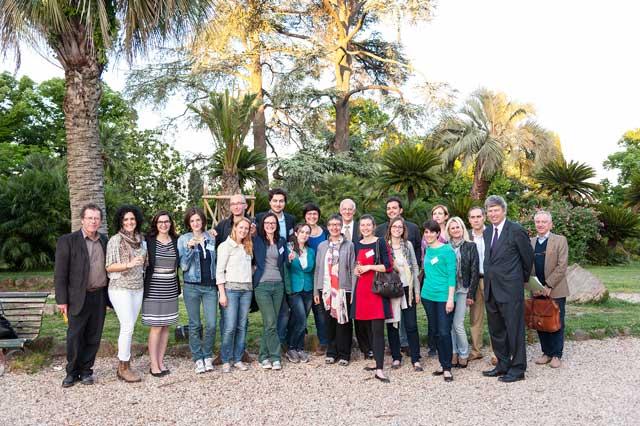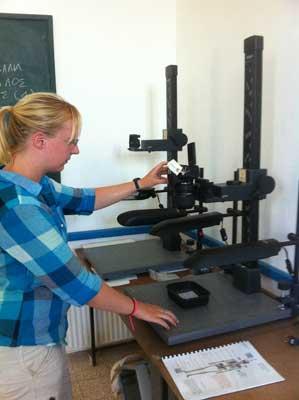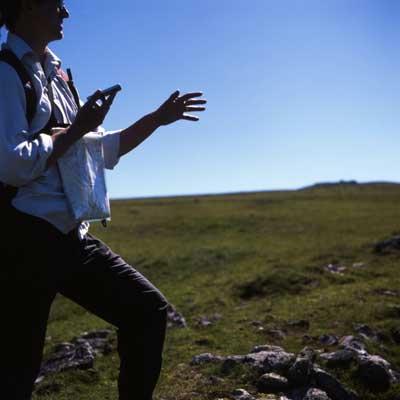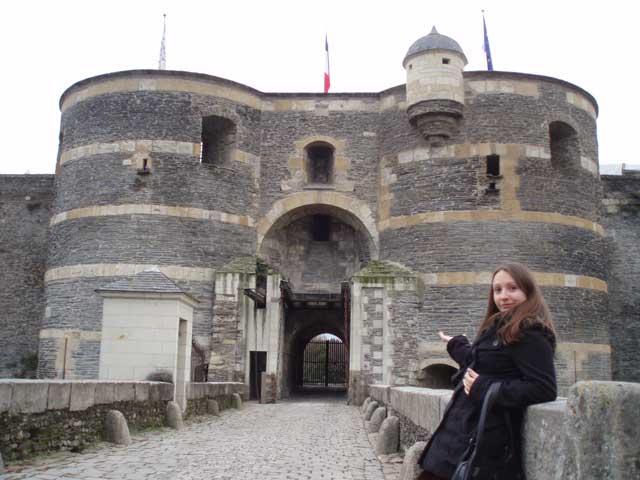Stuart Eve
PhD in Archaeology (2014), MSc in GIS and Spatial Analysis (2005), BSc Archaeology (2000)
Like many others, it turns out I wasn’t quite Cambridge material, but despite the fact that the Institute looks nothing like the great gates of Trinity, I knew from the second I arrived that I had come to the true home of Archaeology in the UK, and an institution that I would be proud to call my academic home for the next decade, and more (although I didn’t quite realise that at the time!). The students showing me round on the open day were happy, lively and genuinely excited about studying there, and that feeling was infectious. I was interested in the breadth of opportunities, the array of available courses on cultures across time and space, and the large required fieldwork component. My time as an undergraduate was happily spent as expected: lots of intense learning and lots of fun. The Institute fostered and embraced these key undergraduate needs and we emerged after three years as well-rounded, extremely well-educated individuals who enjoyed each others’ company. One of the most important parts of my time as an undergraduate were Monday nights in the ‘Phineas’ bar on the 3rd floor of the Union. The bar was a great mixing pot; it would be taken over by all years of undergraduate and postgraduate archaeologists, where all were equally accepted and we were able to build great friendships across the Institute, rather than just within the year group. Rather akin to my subsequent experience of academic conferences, the day is spent listening to lectures, but the real ‘business’ is always done while socialising afterwards.
As an undergraduate in the late 1990s, the possibilities offered by the World Wide Web were just beginning and I wanted to explore them. I was elected as the publications officer for the Society of Archaeological Students (SAS) and as well as producing the various paper publications, I immortalised us in HTML 1.0. Thankfully I have no recollection of what the website looked like, but I imagine there was much overuse of blinking text, garish colours and clip-art. Despite the flashing lights, this experience framed my subsequent career and started me on the road of exploring digital techniques in archaeology. Thanks to the egalitarianism of Monday nights in the Phineas bar, I became firm friends with Guy Hunt (BA Archaeology 1998), who was also President of the SAS. While I was finishing my final exams and wondering what to do next, Guy asked me to come and work with him at a commercial archaeology company: then Archaeological Consultant Services, but which became L – P: Archaeology. We recruited another Institute graduate, Matthew Williams (BA Archaeology 1997), and are all still working together today.
Our company focuses on bridging the commercial and academic worlds, something that is sadly lacking in most of the commercial archaeology companies in the UK. As well as undertaking traditional developer-led archaeological projects, L – P: Archaeology specialise in databases, websites (without blinking text) and GIS (Geographic Information Systems) for archaeological applications and we have a variety of academic and commercial clients – meaning that theory and practice are always in communication. Our focus on GIS and databases was greatly influenced by my part-time MSc at the Institute in GIS and Spatial Analysis (which I later taught), under the direction of my undergraduate dissertation supervisor and later PhD supervisor and mentor, Dr Mark Lake. The MSc taught me technical skills and sophisticated analytical techniques that provide a solid underpinning to all of my digital work at L – P, and as an academic; I cannot overstress how important this grounding has been in helping me to think critically and examine my own and other people’s work. By studying part-time I was able to assess the theoretical techniques explored in the course using ‘real’ archaeological data from my day-job.
L – P’s foot in both academia and commercial archaeology is directly influenced by the time that Guy, Matt, and I all spent at the Institute; we studied archaeology because we love it, but the reality of commercial digging can often be rather unsatisfying for the archaeologist – shifting earth and telling the story the client needs to hear. I believe that theory and practice should always work in concert, and so I returned to the Institute for the third time to study for my PhD in 2008.
It is pertinent for me to recall a lecture from my undergraduate days, by Chris Tilley in 1997. He was presenting the ground-breaking and controversial work that he, Barbara Bender and Sue Hamilton were undertaking on Leskernick Hill on Bodmin Moor in Cornwall. He showed us bizarre slides of people wrapping ancient stones in cling film and spraying them with yellow paint, looking through makeshift wooden doorways in Bronze Age hut circles, and strange models being erected in the landscape. He was attempting to explain his new theories on the phenomenology of landscape to a room of fresh-faced first year undergraduates, and I hate to say it, but instead of being inspired, the majority of the room (including me) was laughing at what we saw as the lunacy of the whole thing. That moment has stayed with me, not because we were incredibly rude (which we were), but because at the time I didn’t realise how privileged we were to have been given that lecture by someone right at the cutting edge of applying archaeological theory in the field. By the time I completed my PhD in 2014 (Eve 2014), the focus of my thesis had become an examination of the intersection between digital methods of visualisation and phenomenology in the landscape, with the main case study being based around Tilley et al.’s work on Leskernick Hill...Who’s laughing now, as I stride about a hillside with an iPad, scent dispensers in a cardboard box, linked over the internet to a remote GIS server and a GoPro video camera attached to my head? The cutting edge of archaeology is always tinged with the ridiculous (Fig. 1).
Anna Paterlini
MA Public Archaeology 2011–2012
“In a simple direct sense, archaeology is a science that must be lived, must be “seasoned with humanity.” Dead archaeology is the driest dust that blows.” Sir Mortimer Wheeler (1956).
Since I started my academic studies, I have always faced a great deal of skepticism about my first degree in Archaeology. I myself was quite confused during my undergraduate years: what’s the point of digging up all that stuff if only very few people really understand it and actually appreciate it? It was in looking for the answer to this question that I stumbled upon Tim Schadla-Hall and his MA in Public Archaeology.
I have always secretly thought the only acceptable aim of archaeology should be to enable people to construct their own past, sharing with them archaeological findings while promoting stewardship of cultural resources. However, it is only after the MA that I could comfortably say that out loud.
The time I spent at UCL Institute of Archaeology was an incredibly captivating academic experience as I was in an environment that extensively supported my learning and research. Although my time there was relatively brief (September 2011 to September 2012), I took advantage of all the opportunities on offer, by attending every seminar possible and volunteering at conferences on campus, before going off to do research for my dissertation.
The Institute provided a really supportive environment. The rigor of the program, the diversity of the student body and professors offered multi-faceted perspectives and taught me how to synthesize these into meaningful, tangible solutions.
Thanks to the professional and academic connections I made through the Institute and the invaluable help from my supervisor, I am now able to do my part, however small, to support the development of Public Archaeology in Italy.
Once I had graduated, I went back to Italy for two internship opportunities: one as research assistant at The American University of Rome (AUR) and one in the Audience Development team at the Herculaneum Conservation Project (HCP). Each quickly led to part-time positions as President’s Assistant for Special Projects at AUR, and Audience Development Consultant at HCP.
Working in the archaeology and heritage field in Italy is not easy. Since the economic crisis and recession kicked off in 2008, Italy has seen its economy grow very slowly both in absolute terms and on an international level, and, as often happens in times of economic hardship, the need to reduce expenses becomes urgent and some areas are affected more than others.
In the past ten years, it has not been unusual to see a recurring question on the news: how is it possible that Italy cannot live off its cultural heritage? This is still a very thorny debate that roots back to – among many other political issues –a fundamental cultural problem. Italian academia and ruling classes cannot accept nor fully understand changing attitudes and perspectives towards cultural heritage. As a consequence, archaeological sites and museums are not seen as relevant to the current society, so are neglected and forgotten.
Over the last two years, I had the opportunity to really make my voice heard and contribute to this debate. One key initiative I am contributing to while at Herculaneum as part of the Audience Development Program is a 12-month campaign of questionnaires for independent visitors. The research, which is the first of its kind in Italy, aims to cluster tourists to Herculaneum under different profiles, in order to eventually produce targeted outreach and interpretation campaigns. Together with other shorter studies targeting non-visitors, organized tours, schools and the local community, the program itself aspires to develop and nurture a relationship between the archaeological site, the local authority managing it and the public over the long term.
At AUR I was given the chance to take charge of a short program to train young Italian graduates and professionals to turn archaeological heritage into an asset for urban tourism (Fig. 2). Introducing them to all the issues relating to public archaeology and cultural resource management and seeing them independently create innovative management strategies, made me extremely proud of my job. My biggest hope is to have been able to challenge their way of looking at archaeological resources -at least one tenth of what Tim Schadla-Hall did for me.

Anna Paterlini (in red) with professors and participants of the masterclass ‘Turning Charlemagne into an asset for Rome’, The American University of Rome, 5–9 May 2014. (Photo A. Cavallini).
Looking back now, that I am about to sign a permanent contract with The American University of Rome, I fully appreciate my UCL experience, an excellent higher education program that has benefited me greatly and changed my life.
Jennifer Willoughby
MSc Skeletal and Dental Bioarchaeology 2011–2012
The year that I spent earning my Masters degree from the Institute of Archaeology was one of the most valuable of my life, both academically and personally. The MSc program in Skeletal and Dental Bioarchaeology exposed me to new modes of thinking and introduced me to a different approach to archaeology than I had previously experienced. Having been trained in the American style of archaeology, I was keen to gain experience in British archaeological and bioarchaeological methods and theory at UCL. I gained that, and so much more, during my time in London.
The extensive resources of the Institute of Archaeology (IoA) enabled me to get the most out of my studies, while the incredible academic staff introduced me to new perspectives on archaeology. I remember attending classes in the Royal College of Surgeons, where I and my course-mates were fascinated by the interesting and rare medical specimens that enhanced our learning environment.
One of the reasons for choosing UCL was the program’s focus on dental anthropology, as it is an important aspect of bioarchaeology. Professor Simon Hillson’s extensive knowledge and experience contributed greatly to my understanding of the vast amount of information that can be accessed through the application of dental anthropology. I particularly appreciated Professor Tony Waldron’s perspective. His experience as a medical professional added depth to my understanding of bioarchaeology and what information can be gleaned from skeletal archaeological material. Dr Carolyn Rando’s engaging teaching style and encouragement helped me to get the most out of my training and to become a better scholar.
The core courses in the MSc provided me with a solid foundation in bioarchaeological methods and theory, while the optional courses I chose introduced me to entirely new topics that I would not have encountered otherwise. In the ‘Modern Conflict Archaeology’ course, I learned about this relatively new field and its unique applications of archaeological theory to events and issues that have occurred within living memory. Through the program and the Institute, I also met a fantastic group of scholars with diverse perspectives, and I am sure that many of them will remain lifelong friends and colleagues.
I also had the opportunity to participate in the Astypalaia Bioanthropology Field School in Greece, directed by Professor Hillson. The project, located on the Dodecanese island of Astypalaia, focuses on material excavated from the largest known ancient child cemetery in the world. The material, mainly neonatal human remains is very delicate, so the field school teaches excavation techniques for recovering these remains from their burials in ceramic pots, and conservation techniques for preserving them for detailed study (Fig. 3). This provides a rare opportunity to work with neonatal human remains, and to learn the precise techniques required to gather as much information from them as possible. Information gained through the project could potentially lead to a greater understanding of the growth and development of the neonatal human skeleton. [Project website: https://sites.google.com/site/astypalaiabioarchaeology/astypalaia-bioarchaeology]

Jennifer Willoughby at the Bioanthropology Field School on Astypalaia, Greece. (Photo R. Schofield).
This was an incredible time of learning and professional growth, gaining hands-on experience in bioarchaeology and being able to apply what I had learned during the coursework. Being on a beautiful island in Greece, surrounded by fantastic Greek food and culture certainly did not hurt! When I was invited to return as a supervisor the following year, I was thrilled. I gained my first teaching experience at the field school, which enabled me to confirm my desire to continue to pursue a career in academia and teaching. I found that I truly enjoyed helping my students grow and providing them with the skills they need to succeed in archaeology. Since graduating from the IoA, I have continued to work with the project as a supervisor because of the friendly, encouraging and academically challenging (and satisfying!) work environment, and because I am able to contribute to a greater understanding of history.
I believe that my time at the Institute of Archaeology provided me with the research and problem-solving skills I need to succeed in my chosen field as well as anything else I decide to tackle later in life. Since graduating from the IoA, I have remained active in bioarchaeology, attending physical anthropology and archaeology conferences around the world and participating in archaeological fieldwork. Additionally, along with a few colleagues, I co-founded the Paleo-oncology Research Organization (PRO), dedicated to the study of cancer in antiquity. Under the aegis of PRO, I co-organized a symposium on cancer in bioarchaeology at the Paleopathology Association’s annual meeting in 2014, to discuss the current state of paleo-oncological research and its future potential. Researchers presented papers on case studies, methodological approaches, and literary and archaeological evidence of cancer in the ancient world. While published case studies of cancer in archaeological human remains have been scarce, there is evidence that the disease was present in, and had an impact on, ancient societies. The standardization of diagnostic methods and recording techniques would enable more case studies to be discovered and shared within the academic community. Application of biomolecular methods, such as proteomics (study of the structure and function of proteins) and ancient DNA analysis, to archaeological remains has great potential to provide information about the forms of cancer present in different environmental and cultural contexts throughout history. Paleo-oncological research has the potential to contribute to a greater understanding of the impact of cancer in the ancient world and to trace the history and evolution of the disease over thousands of years. This, in turn, could shed light on the environmental, cultural, and genetic influences on the development of cancer, and how it develops today.
In autumn 2014, I will begin a PhD program in Bioarchaeology and Archaeology at Western University in Canada, and have accepted funding from the prestigious Ontario Trillium Scholarship. I am looking forward to continuing my bioarchaeological training; building on the foundation I gained at the Institute to become a more valuable member of the academic community. I am most grateful to the Institute of Archaeology for all of the opportunities it has afforded me to successfully follow my passion for the past.
Julie Patenaude
MA Cultural Heritage Studies 2011–12
It’s the summer of 2013, just one year after the completion of my MA in Cultural Heritage Studies from University College London Institute of Archaeology. I stand amongst the leafy trees of London’s Crystal Palace Park quietly staring at an odd cement creature, one of many in the park. I’ve been told that it’s a dinosaur – a Victorian one in fact – but I remain unconvinced. This prehistoric monster has more in common with a chunky, weight-lifting crocodile than the reptiles we have come to know and love. It sits very still, waiting to snatch one of the unsuspecting children running and playing just beyond its reach. Some of the creatures are quite large, while others are very small, but all radiate this air of aggression - and time. This aura of time links to a bygone era when they were valued for the knowledge they disseminated and when they did not suffer from such neglect. Despite their shabby appearance, these cement monsters succeed in sparking my interest and curiosity – as well as that of my English Heritage colleagues. Standing before this unusual, static zoo, we discuss their ‘significance’. What ‘values’ would you ascribe to them? Can we consider this ‘Heritage at Risk’? How can we ‘manage change’ within their setting?
To the uninitiated, these word combinations may mean nothing. They form part of a strange, alien language known as ‘heritage-speak’ – ask anyone who has ever tried to read an English Heritage guidance document on setting or place making. One soon has to suppress the desire to hit one’s head against a brick wall. Thankfully, I find myself perfectly at ease for I have entered the ranks of the initiated, and did so the day I graduated from UCL.
To say that I approached my academic year at the Institute with the tactical precision of a military operation might be a slight exaggeration, but my aim in attending UCL was very much driven by my desire and need to secure regular employment. Previous years spent working on various archaeological projects in Canada and Egypt had taught me of the harsh realities of life as an archaeologist. It was time for a change.
Change came in the form of regular employment in English Heritage’s Planning and Conservation Department, and it soon became apparent that Victorian cement dinosaurs were only going to be the beginning. Within weeks, I was touring the boroughs of southeast London alongside the Historic Buildings Inspectors and the Ancient Monuments Inspectors investigating everything from best practices when repairing wooden floors in Tudor buildings, to proper design principles and issues of setting relating to new builds on World Heritage Sites, and to breathing new life into disused and empty World War II military barracks. Each site visit brought to the forefront of my mind familiar themes which had once formed part of intense, intellectual debates with my classmates and tutors. Concepts of commemoration, negative heritage, and memory-making had now become part of my everyday life and were helping me to make decisions that would have a very real impact on London’s heritage assets (Fig. 4).
Over time, my responsibilities at English Heritage increased and I began to oversee the administration of grant-aided projects. It was then that I fully understood the importance of stakeholder involvement and local engagement in heritage projects as so often discussed during my MA at UCL. I felt privileged for I now had the opportunity to apply this first hand. Many meetings were held with local volunteer groups. Always, we discussed the best way for English Heritage to assist them in their endeavours. They wanted to regain control and autonomy over their local historic environment and we wanted to help them do it. Other times, we provided funds or expert advice to local authorities and charitable organisations, but always with the same aim – local empowerment. There can be no greater feeling of achievement than to reach the completion stage of a restoration project.
I specifically chose the MA in Cultural Heritage Studies programme at the UCL Institute of Archaeology as it allowed me to delve into the theoretical approaches to heritage and its management, and it gave me the practical experience of exhibition design and project management I desperately wanted. Some of my fondest memories of that year spent in Gordon Square revolve around the museum project on student homes that my classmates and I developed with the Geffrye Museum. ‘Finally!’ I said to myself. ‘I’m going to get my hands dirty’. Or so I thought.
For weeks, we explored the different learning theories and delved into the many audience types. We absorbed all the required theory and developed our project’s concept. And then… my classmates went off into ‘the world’ to conduct interviews, write press releases, develop online content, and design creative interpretation panels. The project management team (including myself) stayed behind; we chose to stress and pull our hair out over reaching milestones, delivering outputs, and writing ridiculously long reports. And we loved every minute of it! In the end, the project was a great success. The quality of work and the effort my classmates put into this assignment made certain of it. Should there have been any doubt on our part, the support, extensive knowledge and professionalism of our course tutors ensured that we reached our aim. Today, I apply these practical skills managing my own heritage project for the Church of England.
My year at UCL taught me many things; I learned of the various theoretical approaches one can apply to cultural heritage around the world; I was trained in ‘heritage-speak’ – a necessary skill in heritage management when looking for the ‘value’ in things and assessing their ‘significance’; I learned practical skills in project management, which I apply everyday in my new role. But more importantly, my year at UCL taught me that I will always have the support of my peers – my former classmates who have now found employment around the world, and my former tutors to whom I still reach out on occasion for guidance.



